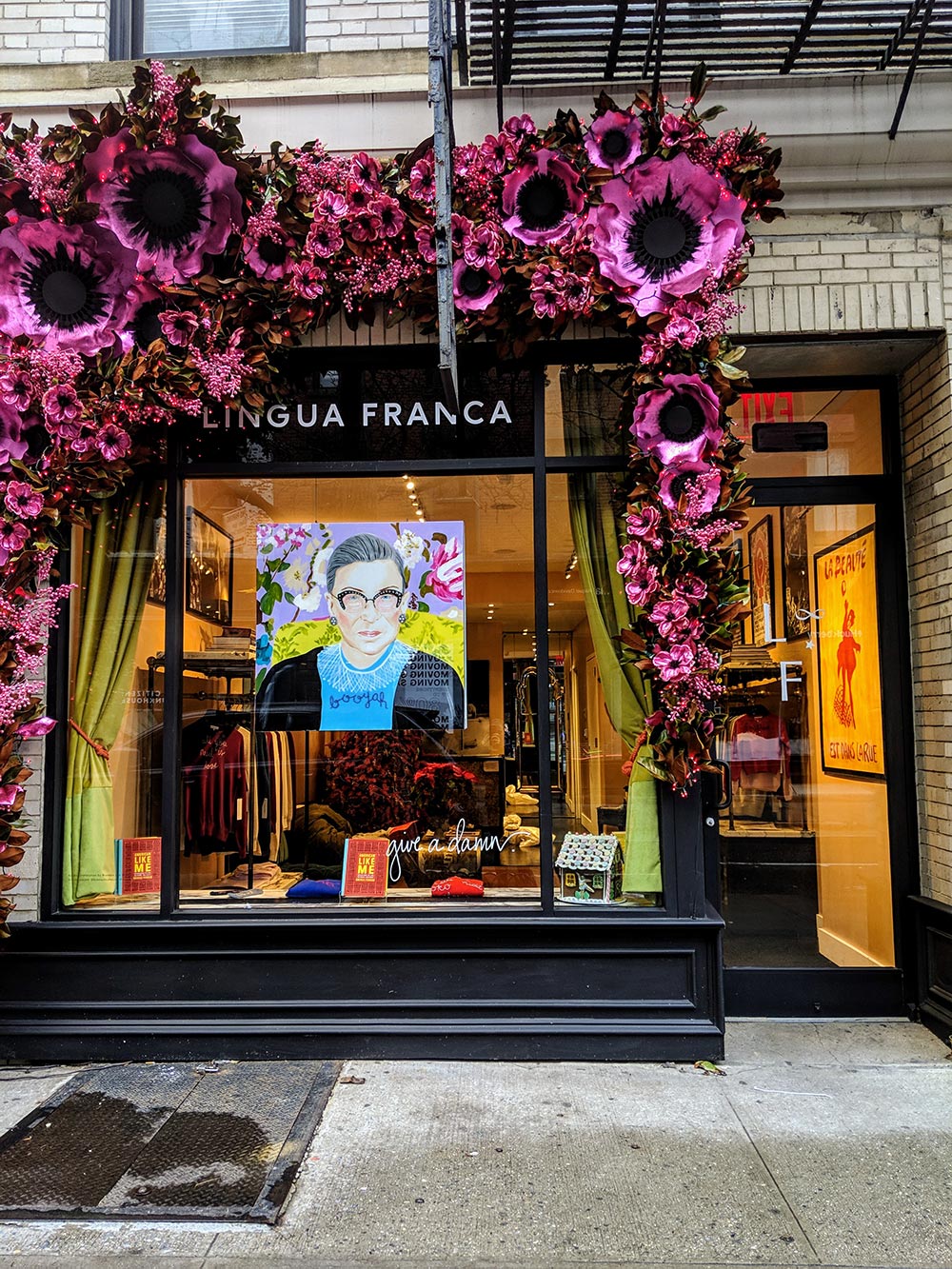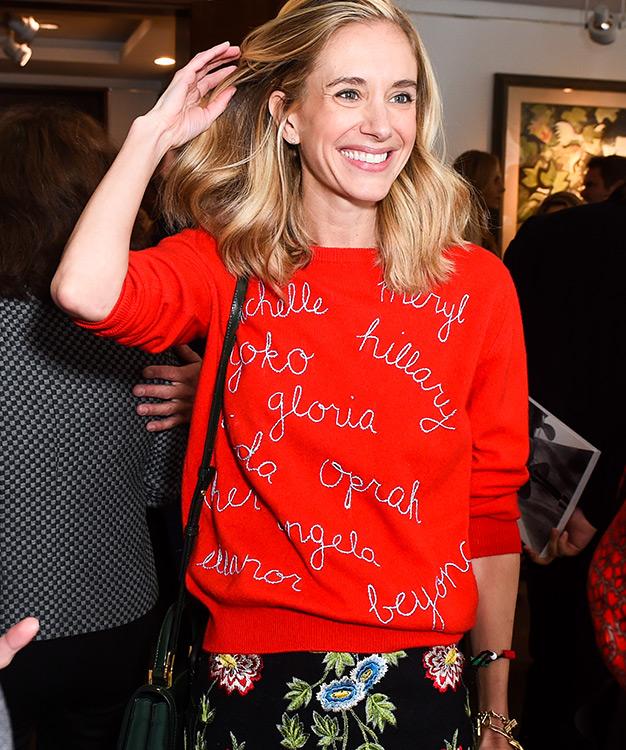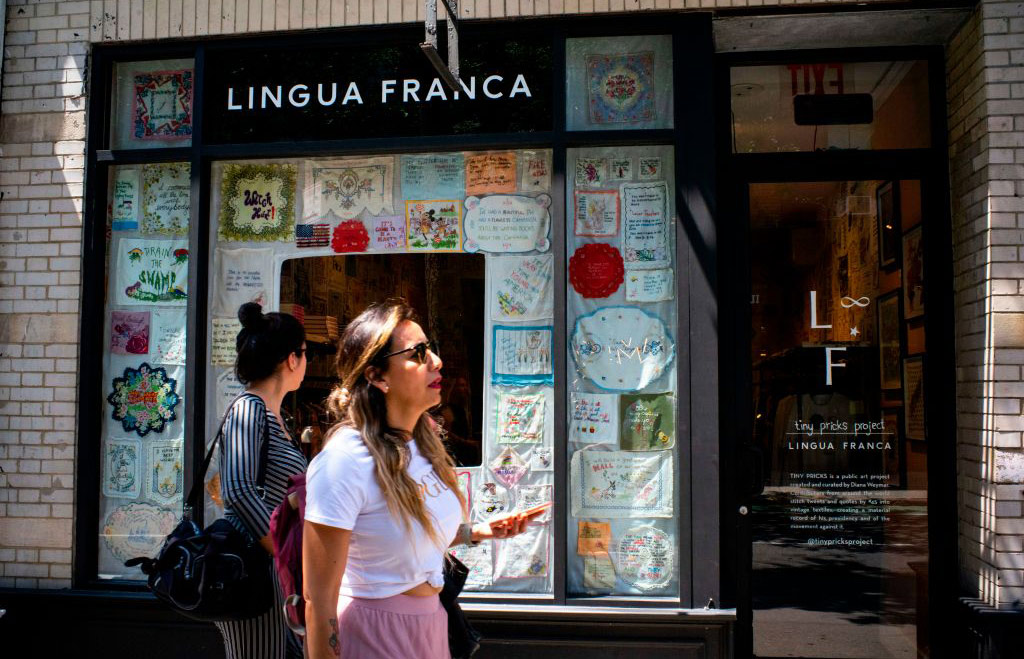当你走过时,很难不注意到最高法院大法官露丝·巴德·金斯伯格那幅夺人眼球的肖像画,她穿着法官袍,领口一圈标志性的绉边,里面是一件知更鸟蛋蓝色的毛衣,上面绣着“booyah”。
这张肖像挂在Lingua Franca品牌纽约西村的精品店橱窗里,正下方的标语写着“我在乎”(Give a damn),完美诠释了这个独立时尚品牌的品牌形象。Lingua Franca成立于2016年,是一家使用可持续原料生产奢侈羊绒毛衣的公平贸易品牌,商品全部由纽约市的女性手工缝制。
《财富》杂志最近采访了Lingua Franca的创始人罗谢尔·鲁斯卡·麦克弗森,讨论了在社会议题和公共健康危机不断的时期,经营一家不断发展的小型零售企业是什么感觉。
为简明起见,以下采访略有删减。

《财富》:过去几年,Lingua Franca标志性的标语刺绣圆领毛衣辨识度越来越高(甚至有人说它已经成为一种风格)。是什么给了你设计灵感,又是什么促使你把灵感转化成一家成熟的企业?
麦克弗森:Lingua Franca是一个意外之喜。我六年级时跟奶奶学会了缝纫和刺绣,后来治疗师建议我培养一个手工爱好来对抗焦虑,去年冬天我重新捡起了这个爱好,开始在旧毛衣上刺绣,其中一件绣了“booyah”。我把其中一些照片发到了Instagram上,有几十个朋友想要。整个故事大概就是从那里开始的,开始有店铺在Instagram上向我订购毛衣。我十分喜欢通用语言(lingua franca)这个概念,人们使用通用语言,这是一种团结。我也很喜欢手工制作的方式,我们的每一件作品都不是批量生产的。
很多明星和网络意见领袖都在穿,LF的毛衣也在Instagram上走红。社交媒体对你的生意产生了什么影响,包括品牌塑造、客户参与、服务等?
对我们而言,这个品牌的一切都是从Instagram起步的,而我们在这个平台社区里遇到的人总是能带给我们惊讶。我们建了实体店后,很高兴能把现实聚会里的内容和活动放到社交平台上,和我们在线社区的客户分享。我仍然亲自运营品牌的社交媒体账号。虽然很花时间,但我觉得这是和客户沟通的最好方式。
明星和网络意见领袖之所以经常穿LF毛衣,部分原因是刺绣文字传达的信息往往在呼应某项公益事业,或者传达出某种社会信息。(我还很清楚地记得女演员特莎·汤普森两年前在颁奖季的一次派对上穿了一件红色刺绣毛衣。那件毛衣上绣了四位女导演的姓,而她们都被卡在了2018年奥斯卡提名之外。)是什么让LF的毛衣成为一个平台?客户的反应如何?有没有人曾经对其中的某些信息表示强烈抵制?
这些都不是我“计划”出来的,作为一家公司,我们顺应潮流,自然而然地从别人那获得灵感。随着人们找我们在毛衣上绣上对他们有意义的词句,“把毛衣作为一个平台”的想法自然而然就出现了。我确实认为,看到手工刺绣文字所花费的心思和时间,的确蕴含着某种独一无二的特质。这又让文字有了更多意义。
当然,我们也收到过反对意见。刚开始,我们的词汇表中有很多嘻哈歌词。我们以为这是对当今时代“通用语”的赞美。后来我们意识到,这种做法侵占了我们不属于的文化。作为回应,我们决定要努力为黑人社区作出贡献,并将这些毛衣从商店里下架。我们并不完美,但我们在倾听和学习。最重要的是,我们不会放弃为这个世界带来爱和正义的努力。我们已经为有意义的事业捐赠了数十万美元,并且将每一笔捐款公之于众,让世界知道我们说到做到!

你们的每一件毛衣都是单独缝制的,而且都是羊绒衫,所以无可否认这些都是高品质的高级服装。但每件毛衣的价格高达280美元到400美元不等。当然,这些都不是快时尚成衣,高品质就意味着高价格。但作为一个积极呼应社会事业的品牌,许多消费者却没有购买这些毛衣的经济能力。你们的定价依据是什么?平心而论,毛衣价格中也包括你们对各种社会慈善机构的捐赠;你能解释一下你们是如何决定捐给哪些团体以及通过销售筹集了多少资金?
我们为已经做出的捐赠感到骄傲,为让世界变得更美好付出的巨大努力感到自豪。不过,每一次合作、每一个项目都各不相同。许多产品的收益都100%捐给了慈善事业。
对我们来说,很重要的一点是确保我们所有的面料都来自符合最高道德标准的环保供应商。我们刺绣工人的工资超过了最低工资,我们也很自豪能够为纽约市大量刺绣工人提供全职工作。当然,正因如此,我们的产品比快时尚行业品质更好,价格也更贵。我认为现在的消费者比以往任何时候都更关心他们的产品来自哪里以及品牌背后的道德标准。我们要确保我们做的每一件事都是经过深思熟虑的,现在这一点比以往任何时候都更重要。
你最近在Lingua Franca的网站上写了一篇关于“黑人的命也很重要”运动(Black Lives Matter)的文章,写了你准备如何利用自身优势做得更好。当然,现在我们应该倾听和学习黑人领导者、尤其是黑人女性领导者的声音,但说到如何才能更好、更积极地为BIPOC(黑人、原住民和有色人种)社区做贡献,你会给其他白人女性创始人什么建议?
我认为倾听很重要,但行动是当务之急,尤其是以白人女性盟友的身份行动。我不喜欢看到白人朋友在为BIPOC社区说话时变得犹豫不决,犹豫的原因是害怕把事情搞砸或者让人认为是在发出道德信号。是的,大声疾呼需要勇气,但我们必须这样做,即使会犯错。现在不是沉默的时候。向社区发出道德信号,展示我们在某个问题上的立场,历史上的变化恰恰就是这么发生的,今后也将继续这样发生。我认为雇佣黑人女性在公司关键岗位任职、让黑人女性融入你的社交圈也很重要。改变必须由内而外。这需要真正付出努力,需要走出舒适区。

众所周知,零售业在相当长一段时间内举步维艰,尤其是实体店,疫情前就这样了。你们有一家精品店位于西村(West Village)的布里克街(Bleecker Street),那片商铺上都是博柏利(Burberry)和马克·雅可布(Marc Jacobs)这样的品牌。而且即便是高端零售商,也无法同时承受租金上涨和业绩下滑的压力。实体店还有什么价值?在疫情期间和疫情过后,你们的精力主要放在哪些销售渠道上?
我之前提到过这个问题,我们的实体店从来都不仅仅是“商店”。从一开始,实体店就是我们品牌的延伸。我们希望拥有现实空间,去碰撞思维,再把线下的东西带回线上。我们的商店每周都举办座谈、问答和作者之夜,也是多位作者和活动家的社区中心。去年夏天,我们甚至摇身一变,成为一个实打实的画廊,为“小刺计划”做了三个月艺术展览。
显然,这个“将商店作为社区空间”的想法在新冠疫情时代发生了一些变化,但我仍然对现实体验充满期待。虽然我们的电商业务大幅发展,我们仍然期待着实体店重新开张,期待继续在现实生活中与人们会面。(财富中文网)
译者:Feb
当你走过时,很难不注意到最高法院大法官露丝·巴德·金斯伯格那幅夺人眼球的肖像画,她穿着法官袍,领口一圈标志性的绉边,里面是一件知更鸟蛋蓝色的毛衣,上面绣着“booyah”。
这张肖像挂在Lingua Franca品牌纽约西村的精品店橱窗里,正下方的标语写着“我在乎”(Give a damn),完美诠释了这个独立时尚品牌的品牌形象。Lingua Franca成立于2016年,是一家使用可持续原料生产奢侈羊绒毛衣的公平贸易品牌,商品全部由纽约市的女性手工缝制。
《财富》杂志最近采访了Lingua Franca的创始人罗谢尔·鲁斯卡·麦克弗森,讨论了在社会议题和公共健康危机不断的时期,经营一家不断发展的小型零售企业是什么感觉。
为简明起见,以下采访略有删减。
《财富》:过去几年,Lingua Franca标志性的标语刺绣圆领毛衣辨识度越来越高(甚至有人说它已经成为一种风格)。是什么给了你设计灵感,又是什么促使你把灵感转化成一家成熟的企业?
麦克弗森:Lingua Franca是一个意外之喜。我六年级时跟奶奶学会了缝纫和刺绣,后来治疗师建议我培养一个手工爱好来对抗焦虑,去年冬天我重新捡起了这个爱好,开始在旧毛衣上刺绣,其中一件绣了“booyah”。我把其中一些照片发到了Instagram上,有几十个朋友想要。整个故事大概就是从那里开始的,开始有店铺在Instagram上向我订购毛衣。我十分喜欢通用语言(lingua franca)这个概念,人们使用通用语言,这是一种团结。我也很喜欢手工制作的方式,我们的每一件作品都不是批量生产的。
很多明星和网络意见领袖都在穿,LF的毛衣也在Instagram上走红。社交媒体对你的生意产生了什么影响,包括品牌塑造、客户参与、服务等?
对我们而言,这个品牌的一切都是从Instagram起步的,而我们在这个平台社区里遇到的人总是能带给我们惊讶。我们建了实体店后,很高兴能把现实聚会里的内容和活动放到社交平台上,和我们在线社区的客户分享。我仍然亲自运营品牌的社交媒体账号。虽然很花时间,但我觉得这是和客户沟通的最好方式。
明星和网络意见领袖之所以经常穿LF毛衣,部分原因是刺绣文字传达的信息往往在呼应某项公益事业,或者传达出某种社会信息。(我还很清楚地记得女演员特莎·汤普森两年前在颁奖季的一次派对上穿了一件红色刺绣毛衣。那件毛衣上绣了四位女导演的姓,而她们都被卡在了2018年奥斯卡提名之外。)是什么让LF的毛衣成为一个平台?客户的反应如何?有没有人曾经对其中的某些信息表示强烈抵制?
这些都不是我“计划”出来的,作为一家公司,我们顺应潮流,自然而然地从别人那获得灵感。随着人们找我们在毛衣上绣上对他们有意义的词句,“把毛衣作为一个平台”的想法自然而然就出现了。我确实认为,看到手工刺绣文字所花费的心思和时间,的确蕴含着某种独一无二的特质。这又让文字有了更多意义。
当然,我们也收到过反对意见。刚开始,我们的词汇表中有很多嘻哈歌词。我们以为这是对当今时代“通用语”的赞美。后来我们意识到,这种做法侵占了我们不属于的文化。作为回应,我们决定要努力为黑人社区作出贡献,并将这些毛衣从商店里下架。我们并不完美,但我们在倾听和学习。最重要的是,我们不会放弃为这个世界带来爱和正义的努力。我们已经为有意义的事业捐赠了数十万美元,并且将每一笔捐款公之于众,让世界知道我们说到做到!
你们的每一件毛衣都是单独缝制的,而且都是羊绒衫,所以无可否认这些都是高品质的高级服装。但每件毛衣的价格高达280美元到400美元不等。当然,这些都不是快时尚成衣,高品质就意味着高价格。但作为一个积极呼应社会事业的品牌,许多消费者却没有购买这些毛衣的经济能力。你们的定价依据是什么?平心而论,毛衣价格中也包括你们对各种社会慈善机构的捐赠;你能解释一下你们是如何决定捐给哪些团体以及通过销售筹集了多少资金?
我们为已经做出的捐赠感到骄傲,为让世界变得更美好付出的巨大努力感到自豪。不过,每一次合作、每一个项目都各不相同。许多产品的收益都100%捐给了慈善事业。
对我们来说,很重要的一点是确保我们所有的面料都来自符合最高道德标准的环保供应商。我们刺绣工人的工资超过了最低工资,我们也很自豪能够为纽约市大量刺绣工人提供全职工作。当然,正因如此,我们的产品比快时尚行业品质更好,价格也更贵。我认为现在的消费者比以往任何时候都更关心他们的产品来自哪里以及品牌背后的道德标准。我们要确保我们做的每一件事都是经过深思熟虑的,现在这一点比以往任何时候都更重要。
你最近在Lingua Franca的网站上写了一篇关于“黑人的命也很重要”运动(Black Lives Matter)的文章,写了你准备如何利用自身优势做得更好。当然,现在我们应该倾听和学习黑人领导者、尤其是黑人女性领导者的声音,但说到如何才能更好、更积极地为BIPOC(黑人、原住民和有色人种)社区做贡献,你会给其他白人女性创始人什么建议?
我认为倾听很重要,但行动是当务之急,尤其是以白人女性盟友的身份行动。我不喜欢看到白人朋友在为BIPOC社区说话时变得犹豫不决,犹豫的原因是害怕把事情搞砸或者让人认为是在发出道德信号。是的,大声疾呼需要勇气,但我们必须这样做,即使会犯错。现在不是沉默的时候。向社区发出道德信号,展示我们在某个问题上的立场,历史上的变化恰恰就是这么发生的,今后也将继续这样发生。我认为雇佣黑人女性在公司关键岗位任职、让黑人女性融入你的社交圈也很重要。改变必须由内而外。这需要真正付出努力,需要走出舒适区。
众所周知,零售业在相当长一段时间内举步维艰,尤其是实体店,疫情前就这样了。你们有一家精品店位于西村(West Village)的布里克街(Bleecker Street),那片商铺上都是博柏利(Burberry)和马克·雅可布(Marc Jacobs)这样的品牌。而且即便是高端零售商,也无法同时承受租金上涨和业绩下滑的压力。实体店还有什么价值?在疫情期间和疫情过后,你们的精力主要放在哪些销售渠道上?
我之前提到过这个问题,我们的实体店从来都不仅仅是“商店”。从一开始,实体店就是我们品牌的延伸。我们希望拥有现实空间,去碰撞思维,再把线下的东西带回线上。我们的商店每周都举办座谈、问答和作者之夜,也是多位作者和活动家的社区中心。去年夏天,我们甚至摇身一变,成为一个实打实的画廊,为“小刺计划”做了三个月艺术展览。
显然,这个“将商店作为社区空间”的想法在新冠疫情时代发生了一些变化,但我仍然对现实体验充满期待。虽然我们的电商业务大幅发展,我们仍然期待着实体店重新开张,期待继续在现实生活中与人们会面。(财富中文网)
译者:Feb
It’s hard to walk by and not notice a glittery portrait of Supreme Court Justice Ruth Bader Ginsburg, painted in her judicial robe and trademark jabot…but also a robin’s egg blue embroidered sweater that reads “booyah.”
Framed in the window just above the slogan “Give a damn,” the portrait at Lingua Franca’s West Village boutique in New York City captures the independent fashion label’s brand perfectly. Founded in 2016, Lingua Franca is a line of sustainably sourced, fair trade luxury cashmere sweaters—all hand-stitched by women in New York City.
Fortune recently spoke with Lingua Franca founder Rachelle Hruska MacPherson about what it has been like running a small retail business with a growing platform during a time of social discourse and a public health crisis.
The following interview has been lightly edited and condensed for clarity.
Fortune: Lingua Franca’s signature crewneck sweater with cursive embroidered messages has become instantly recognizable (and some might even say iconic) in the past few years. What inspired that particular aesthetic, and what motivated you to make it a full-fledged business?
MacPherson: Lingua Franca started as a happy accident. I learned how to sew and embroider from my grandma when I was in sixth grade, and after my therapist suggested I find a hobby to do with my hands to combat my anxiety, I picked it back up again last winter on my own old sweaters, stitching “booyah” into one. I posted a few to Instagram, and I had dozens of friends start asking for them. It sort of started from there as I got stores asking over Instagram to stock the sweaters. I absolutely adore the idea of a common language—a lingua franca—among people as a form of unity. I also loved the fact that each one is done by hand and is the opposite of mass-produced.
LF’s sweaters have also surged in popularity as they are worn by celebrities and influencers all over Instagram. How does social media play a role in your business, from shaping your brand to customer engagement and service?
Everything got started on Instagram for us, and I’m continually amazed by the community of people we have met through the platform. When building out our brick-and-mortar stores, we were excited to be able to bring content from real-life meet-ups and events back online and to share them with our online social community. I still personally run our social media accounts. It is time-consuming, but I feel it’s the best way to engage with our customers.
Part of why the celebs and influencers are often seen with LF sweaters are the embroidered messages, which often reflect a charitable cause or social message. (I keenly remember actress Tessa Thompson wearing a LF red embroidered sweater at a party during awards season two years ago. The sweater had the first names of four female directors shut out from nominations at the 2018 Oscars.) What motivated making the sweaters into a platform? What has feedback been like from customers? Have you ever received any backlash over any of the messages?
Because I never “planned” any of this, we as a company have been able to go with the flow and riff off inspiration from others in real time. The “sweaters as a platform” piece has happened naturally as people started approaching us to hand-stitch words that matter to them. I do think there is something unique and special about seeing the care and time it took to hand-embroider words. It somehow gives them more meaning.
And, of course we have received backlash over some messages. In our beginning, we had many hip-hop lyrics in our repertoire. We thought it was a celebration of words that were the “lingua franca” of our times. We have since realized how this was appropriation of a culture we didn’t belong to. In response, we decided to make significant contributions to the Black community and remove them from our shop. We aren’t perfect, but we are listening and learning. Most importantly, we aren’t giving up in our fight to put love and justice into the world. We have donated hundreds of thousands of dollars to causes that are meaningful to us, and publicize each donation so the world knows we will put our money where our mouth is!
All the sweaters are individually stitched, and they are made from cashmere, so admittedly these are quality and luxury clothes. But pricing ranges from $280 to $400 per sweater. Certainly, these aren’t fast-fashion products, and quality demands a higher price. But for a brand that aligns itself with social causes, there is a socioeconomic barrier for many consumers to buying these sweaters. What goes into setting the prices where they’re at? To be fair, prices include donations to various social charities; could you explain more about that process in terms of how you decide on which groups to donate to and how much has been raised through sales?
We are so proud to be able to make the donations we have been able to make, and make significant strides in making the world better. That being said, each and every collaboration and cause is different and unique. Many items donate 100% of their proceeds to a cause.
It is also very important to us to make sure we are sourcing all of our fabrics from eco-friendly sources with the most ethical standards possible. Our embroiderers make above minimum wage, and we are proud to be able to provide full-time jobs to many embroiderers in New York City. This all, of course, makes our product both superior and more expensive than something you will find in the fast-fashion industry. Right now, I think consumers care more than ever about where their products are coming from and the ethics of the brands behind them. It’s important now more than ever to make sure we are thoughtful in everything we do.
You recently wrote a blog posted to Lingua Franca’s website about Black Lives Matter, explaining how you want to use your privilege to do better. While noting that this is a time we should be listening and learning to Black leaders, especially Black women, what would you say to other white female founders about how they could do better and work harder for BIPOC communities?
I think listening is important, but I also think acting is imperative right now, especially as a white woman ally. I hate seeing white friends become hesitant about speaking out for the BIPOC community because they are afraid of messing up or virtue signaling. Yes, it’s terrifying to speak up, speak out, but we must, even though mistakes will be made. This is not a time to be silent. Virtue signaling to our communities on where we stand on issues is literally how change has happened historically, and it’s how it will continue to happen today. I think it’s also important to hire Black women in key roles in your company, and to incorporate Black women into your close social circle. Change has to happen from within. It takes real work and coming out of comfort zones.
It’s no secret that retail has been suffering for quite some time—bricks and mortar especially, even before the pandemic. One of your boutiques is on Bleecker Street in the West Village, a stretch of real estate that had recently hosted the likes of Burberry and Marc Jacobs. But even higher-end retailers can’t line up the rising rent with falling store sales. What value is there still for brick-and-mortar locations? And during and post-pandemic, which sales channels will you be focusing on most?
I touched on this earlier, but our brick-and-mortar stores were never seen as just “stores.” From the start, they were extensions of our brand. We wanted real-life spaces to activate ideas and bring those things back online. Our stores held weekly panels, Q&As, and author nights, and have been community centers for so many authors and activists. We even became a full-on gallery for an art exhibit—the “Tiny Pricks Project”—for three months last summer.
Obviously, this “store as a community space” idea has changed a bit during COVID times, but I’m still long on real-life experiences. While our e-commerce has been significantly higher, we are still looking forward to reopening in bricks and mortar and continuing to meet people in real life.






